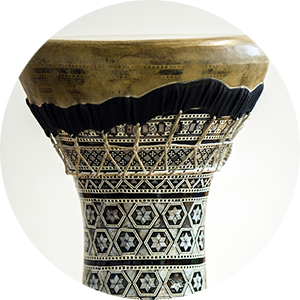
Darabuka

Darabuka course
The main focus of the Darabuka lessons is to teach the playing techniques based on traditional Arabic rhythms. Sebastian will introduce you to the different ways of playing the Darabuka. Together you will discover the unique sounds of this instrument and learn to play finger rolls. Later in the class you will turn to the odd time signatures of 5, 7 and 9 and then learn the complex and virtuosic grooves with the split hand technique.
Sebastian will show you how to strengthen and develop your own musical creativity. There will be a lot of improvisation and composition in the different musical contexts.
Darabuka group course
The Darabuka is a drum from the Arabic region. It is usually played sitting on the left thigh and is held by the left forearm. All ten fingers are used.
There are two basic beats of the Darabuka. By playing between the center and the edge of the drum, a bass tone is produced. Playing with the fingers directly on the rim produces a high tone. Due to the goblet-like shape, a distinctive sound is created.
Traditionally, the darabuka was made of clay and covered with fish or goat skin. Today the instrument is mostly made of metal, aluminum and brass sheet and the playing side is replaced by plastic.
Darbukas have their origin in Arabic music. In the last 15 years, Turkey has developed its own style of playing (split hand technique), which is more closely oriented to Indian tabla playing styles.
Teacher
Mohamed Askari
Yaser Bayat
Region of origin
Middle East, Arab North Africa
Related curses
Arabic Percussion
Oriental Perkussion
Tombak


